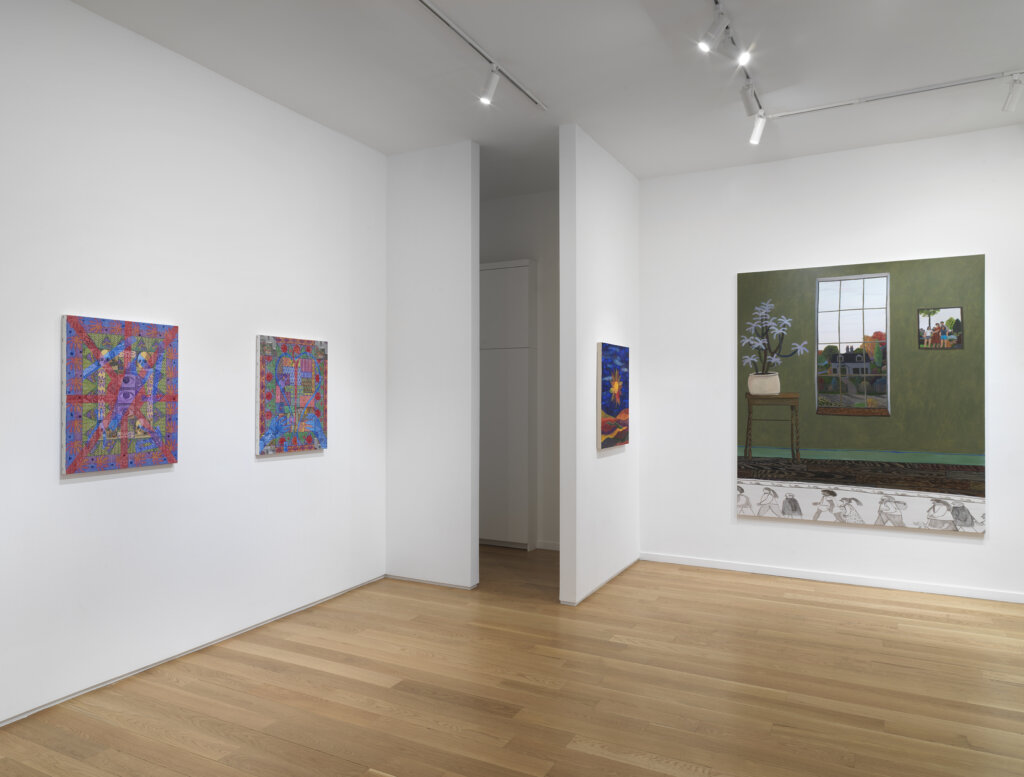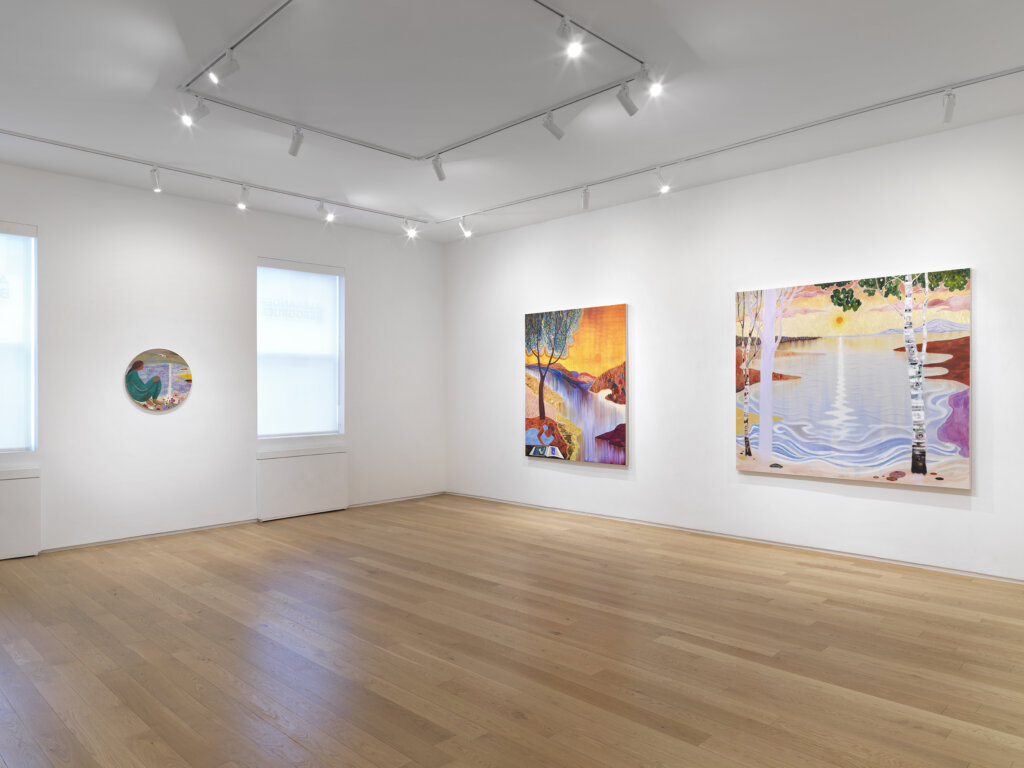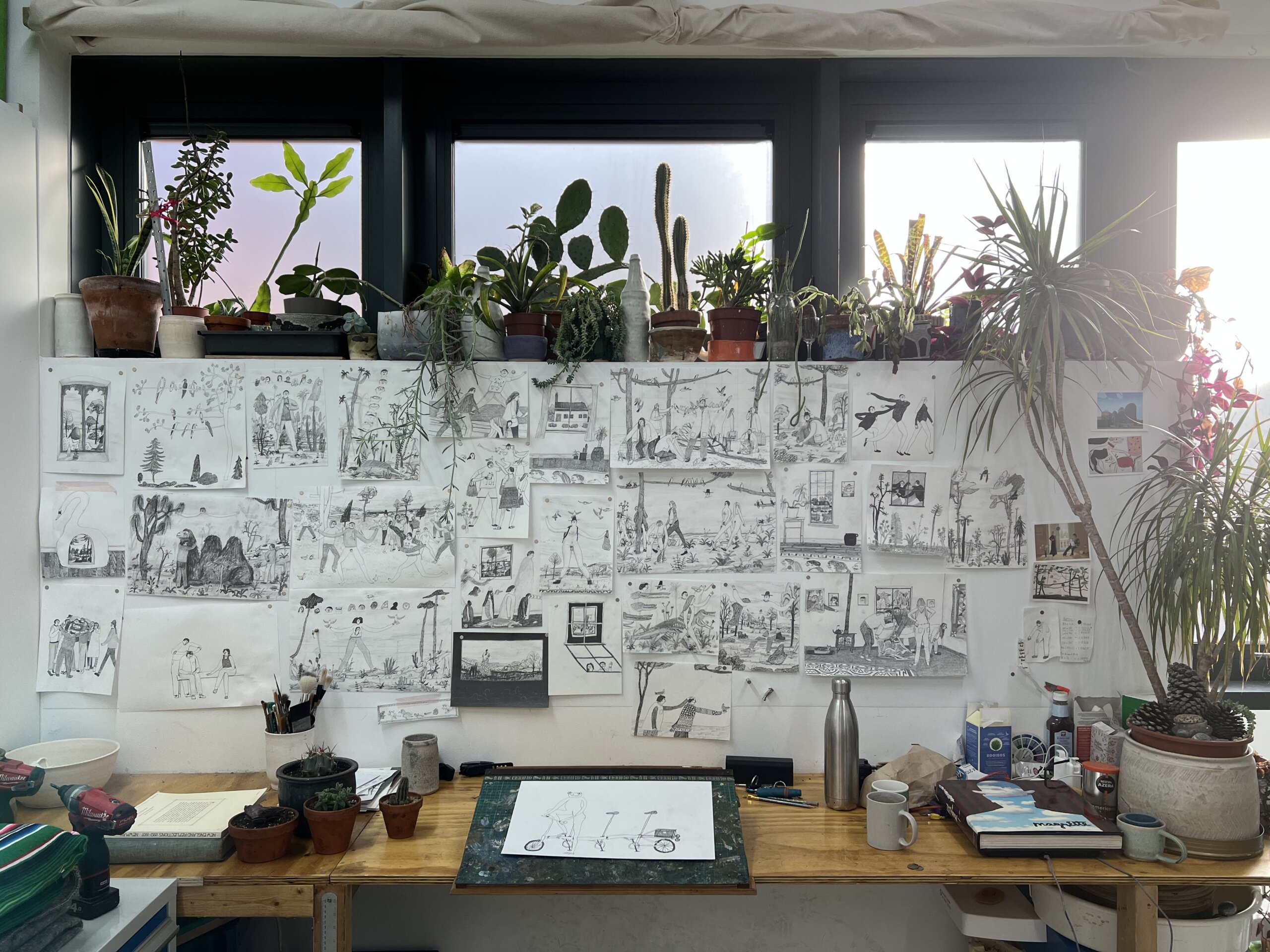
Freya Douglas-Morris, Tom Howse, Talia Levitt (July 20-August 31, 2022) at Alexander Berggruen, New York.
On the occasion of our exhibition Freya Douglas-Morris, Tom Howse, Talia Levitt (July 20-August 31, 2022), we spoke with the London-based artists Freya Douglas-Morris and Tom Howse about their work.

London-based artist Freya Douglas-Morris depicts jewel-toned environments that appear to vibrate and shimmer as if from an internal light source, inspired by remembered and imagined spaces.
Q: You boldly apply color, forming sometimes surprising combinations, especially in the reflections on water where rust red meets army green, ochre, magenta, and blues. How do you determine your confident, sometimes unconventional, color decisions?
The colors are influenced more by emotion and atmosphere than being visually anchored in reality. My desire is to make a painting hummm, catch that frequency where the colors are working evocatively, reacting together to create an energy.

Freya Douglas-Morris
Light is an invitation to happiness, 2022
oil on canvas
65 x 72 7/8 in. (165 x 185 cm.)
Q: Your attention to light and its influence in the sky and on clouds, water, mountains, trees and everything in between is abundantly clear in this body of work. Yet, in working from your memory, this light is largely emerging from your mind. How do you conceptualize light within your fabricated landscapes, considering how it will affect each element?
Because the image is largely memory-based, the sense of light comes from an imagined feeling of light, how it might radiate, wrap itself around the land and sky. Rather than depict the image of a sun, for example, I might try to make the painting glow as if the sunlight is coming from within the painting, emanating out of it, if possible. This is one of the many things I am trying out in the studio at the moment.
Q: Both Afternoon reading and Seeds sown by the sea depict faceless figures within their compositions. Could you please share some insight into figuration as it relates to your work?
I think it is interesting to see what you can give, when you take things away. By leaving elements flattened and paired down, the figures become vessels for the human form as opposed to specific people. You lose definitive time, place and era, they become universal, a human shape on which to place your own associations.

Freya Douglas-Morris’s studio, London, UK, 2022.
Q: Afternoon reading features a reclining figure mimicking a pose with her hand on her head, similar to the figures in the Matisse book open in front of her. What most intrigues you about Matisse’s work?
There are many things that interest me, his sense of color being one, the purity of it and the way the colors resonate. His use of space, playfulness, tenderness, his sense of design. The lightness of his hand, the way his paintings feel limitless and free, unlabored yet considered.

Freya Douglas-Morris
Afternoon reading, 2022
oil on canvas
67 x 57 in. (170.2 x 144.8 cm.)
Q: When painting, you employ varying techniques of applying oil paint, which results in a broad variety of textures within your work. Could you please describe a few of the different approaches you used when painting some of the works in this show?
I use varied techniques in different layers and areas of the painting, to give sections alternating pace, mood, tempo. Washes, drips, brushy, wiping back, painting on the floor, painting on the wall. I ask myself – can I make this area feel printed, woven, washed out, can this area feel light, dense, glow damply or shine darkly? By trying so many varied approaches, it keeps me interested and curious, which I think in turn makes for a more dynamic image.

London-based artist Tom Howse’s delightful bizarreries invite viewers into destabilized realities within homely interiors furnished with ornate wooden furniture and an overabundance of potted plants. Straddling realities and temperaments, Howse affectionately guides the viewer with lovable figures and humor to raise queries about quotidian life.
Q: Who are the characters in your paintings? What do they represent?
Regarding the figures in the rugs/alternative plane of narrative etc., to me, I see them as all the people you’ll never meet, all the people you pass on the street everyday, each with their own lives and complexities and experiences and feelings, they’re the extras in the movie that is your life. Painting them in this format allows them to exist in sort of a supplementary way. They’re not main characters in the narrative, but they are just as important.
Q: The Warm Euphoria I Feel When I Watch You Passing By and Woman With A Frog On Her Head feature amicable amphibians, while In The Hurricane Of Content and Ducks Dreaming Delicate Delights depict feathery friends. What is the importance of animalia in your paintings?
I don’t think it’s that important why I use animals. They have some significance, but mostly I just like animals, and they’re fun to paint and draw. I have two cats myself and I enjoy watching them, they have all these very subtle behaviors and non verbal forms of communication.
Animals can be quite satirical (perhaps satirical isn’t quite right here), their characters are usually divorced from the primary/ human narrative. I don’t know if you have it in the states, but there’s a very good British animation called “Wallace and Gromit”, Gromit was a dog, he never spoke but was the most expressive character, and always managed to highlight and somehow excuse Wallace’s fallibilities.

Tom Howse
Ducks Dreaming Delicate Delights, 2022
acrylic on canvas
74 3/4 x 67 in. (190 x 170 cm.)
Courtesy of the artist and Galleri Opdahl.
Q: By filling your paintings with houseplants and furniture, you’re drawing attention to horror vacui — the fear of empty space. What aspects most intrigue you about humans’ or society’s attempt to connect with the natural world by filling interior spaces with flora and wood furnishings? Might you be willing and able to share a photo of the decor in your own studio?
I love the phrase ‘horror vacui’, I’ve never heard that term before. But I wouldn’t say that’s the key here.
There are endless reasons why plants are interesting, in and out of the home, they’re fascinating, and they make you feel good. But there are two things I’ll say in connection to my work: firstly is the endless variety of species, it’s virtually impossible to make up a weird plant. Nature has already made something much weirder than anything I can come up with, you basically can’t draw a ‘wrong’ plant. And the second point is that the plants I draw often possess a common language of their forms. I’m very particular about the quality of the lines I draw in my plants: the weight of their branches, their sculptural properties, the angle of the leaves, their colors. And they are so malleable to draw; you can adjust the composition anyway you want with plants.
I always get very excited about cacti and succulents, and also plants which look prehistoric like bromeliads and ferns and cycads, not only do they transport you geographically or climatically, but chronologically as well. I love those old illustrations of dinosaur landscapes from books, these weird steamy worlds out of time with wild ancient plants, they get me so excited!

Tom Howse’s studio, London, UK, 2022.
Q: The titles of your work offer an extra narrative layer and insight into the scenes you paint. Could you provide some insight into some of your titles for some of the works in this show? I’m especially curious about the language you chose for In The Hurricane Of Content and The Warm Euphoria I Feel When I Watch You Passing By.
I like some titles to function like very short poems, I like using devices like alliteration, consonance and rhyme, so the flow of the titles sound nice. I sometimes use the titles to challenge the image, so on the surface, most of my work is joyous and happy, which I want it to be, but like with In The Hurricane Of Content, ‘Hurricane’ is a violent and destructive word to use in conjunction with an idea of being ‘Content’.
I sometimes like the poetry to be completely over the top or too emotional for what it is, and then I can also undermine that poetry with a title like Woman With A Frog On Her Head and bring it back down to earth again. It’s all quite silly, but I like the absurdity you can play with when titling work.

Q: There are moments within your compositions that appear to reveal hidden realms, including paintings within your paintings. This push and pull between fact and fiction, reality and unreality in your work has the capacity to cause doubt in a close viewer’s mind. How do you find the balance to straddle these binary modes of thinking when creating your compositions? Could you please share a bit about these worlds within worlds?
Artists have always played with images within images in many formats. For me it’s the destabilization of reality which I enjoy. There is also what’s known as the Droste effect, where the image of itself repeats within itself, like the infinity of two mirrors facing one another. A lot of my work has a very shallow depth, almost like a theater set or a scenic backdrop in a zoo or botanical garden. But painting a view out of a window helps me to access another language within my practice, and it plays with questions of reality, whether I’m painting a view to another place, or painting a painting of a view to another place. When you get into that negotiation of the image, everything becomes questionable, and I love the doubt this provokes.
Freya Douglas-Morris, Tom Howse, Talia Levitt (July 20-August 31, 2022) at Alexander Berggruen, New York.
Artwork and Installation Photos: Dario Lasagni